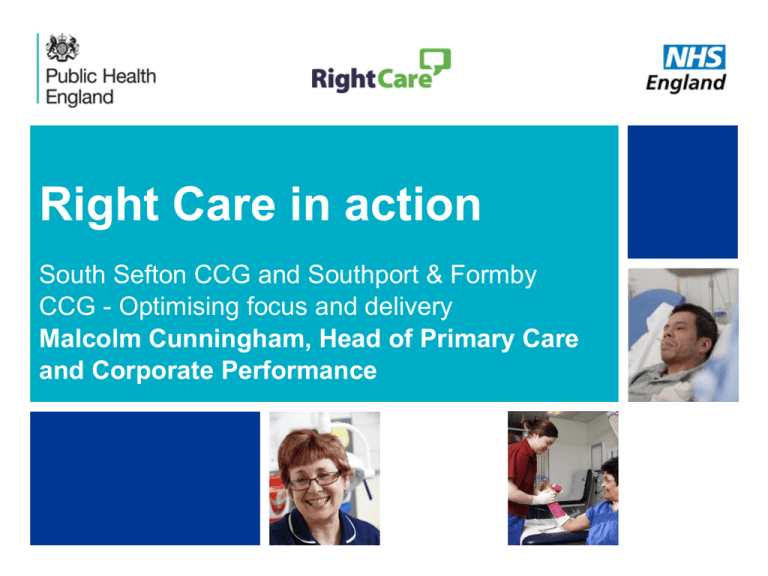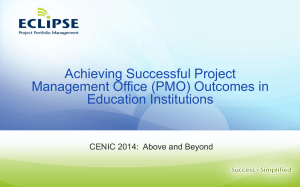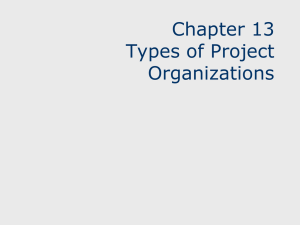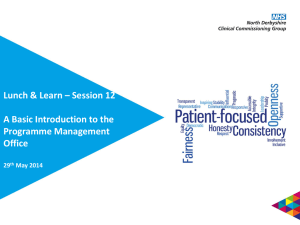Commissioning intentions
advertisement

Right Care in action South Sefton CCG and Southport & Formby CCG - Optimising focus and delivery Malcolm Cunningham, Head of Primary Care and Corporate Performance 1 NHS | Presentation to [XXXX Company] | [Type Date] Optimising focus on reform • Align corporate processes to support reform proposals and delivery • Filter proposals to those that can and should be delivered (Prioritise the priorities!) • Focus governing body and committee decision-making time on reform • Focus ALL directorates/ support functions on proposing change, proving case for change and delivering change 2 Our vision: We want to work with the local community & other partners, to improve the health and healthcare of everyone living in south Sefton, spending money wisely, & supporting clinicians to do the best job they can Context Strategic Consolidate robust Strategic Plan within the CCG financial envelope Corporate Objectives Establish the Programme Management approach and deliver the CCG programmes for whole system transformation, reduction in health inequalities and improved CCG performance Collaborate with the C&M CSU to ensure delivery of successful support to the CCG Strengthen engagement of CCG members, partners and stakeholders Improving quality of Life Optimising use of Secondary Care Enhance systems to ensure quality and safety of patient care Drive clinical leadership development through Governing body, locality and wider constituency development to home Support Older People & those with long term conditions & disabilities to remain independent in own homes Support people early to prevent and treat avoidable illnesses and reduce health inequalities Seek to address social & economic issues which contribute to poor H&WB Ensure all children have positive start in life 3 CCG/ LA Joint Priorities Winter Pressures Children & Young People Everyone Counts Adults Public Health Fundamentals of Care Ensuring Cost Effective ness in High Quality Tertiary Care Financial Challenge Health and Wellbeing Board Objectives Safe Care Build capacity & resilience to empower & strengthen communities Programmes Any Qualified Provider • • • • • • • • Reduce emergency admissions to secondary care Reduce Follow Up Appointments Reduce Readmissions Redesigned community services to reduce hospital attendances and manage care more effectively in a community setting Increased independence of the frail & old Reduction in avoidable admissions Increased integration Reduce non elective admissions over 65’s – 5% ‘13/14, 20% by ‘16/17 Long Term Conditions • Primary Care LES primary care to improve diagnosis management of Atrial Fibrillation Vascular Health Checks Further investment in community respiratory services Primary care risk stratification • • • • Reduced admissions with LTC as primary diagnosis Person centred, integrated primary care provision Reduction under 75 mortality rates Earlier diagnosis of respiratory illness Diabetes • Performance management of IGR diabetes prevention pathway with Public Health Benchmark practices against treatment targets and offer additional support to those not achieving. Review training of staff in primary care in relation to diabetes Ensure patients receive foot care/screening Review multi-professional input into care homes • • • Decreased numbers of unnecessary emergency admissions Increase numbers of nine processes being recorded Increased numbers of people being referred to Healthy Lifestyle services Achievement of Care Programme Approach (CPA) follow up target. Ensure full roll out of the access to psychological therapies programme to deliver a recovery rate of 50%. Increase Dementia detection. including care home staff liaison (51% to 75% by 2015/16) Refresh Sefton Dementia strategy Locality approach via psycho-geriatrician service Adoption of quality of life principles, safe models of care • • • Review ADHD services Review of Children’s Equipment Services Review pilot of Community Children’s nursing team Collaborative working with NCB/LA re: Health visitor and school health national implementation plans Review the Health economy recommendations which result from the Youth offending service inspection • • • • Implement Community Ophthalmology Schemes Better Care Better Value benchmark indicators to support improved performance Any Qualified Provider procurements podiatry, audiology and MSK Promote use of dyspepsia pathway Commission Gynaecology community service pilot • Develop CQUIN increase breastfeeding rates Develop an obesity strategy and clarify obesity treatment pathway. Commission Alcohol Liaison Service at Aintree University Hospital Build capacity to facilitate the provision of Identification and Brief Advice(IBA) across ranges settings • • • • • • • • • • • Programme Management Office Mental Health • • • • • • Information Management Technology Innovation Children Value for Money through Finance and Contracting Planned Quality of Care Improving Outcomes Pro active case management Reviewing patient pathways with Aintree for emergency patients Support of the Community Geriatrician Supporting Nursing and Care homes Evaluation of Out of Hours service and 111 Risk stratification / Pro active case management Investment in Community services Health care acquired infections Roll out of Virtual Ward Virtual Ward The Francis Report Transformational Change • • • • • • • • • Unplanned CQUINs Improving Quality of Primary Care and Delivery of Community Services Promote positive mental health & wellbeing Care closer Enabling Themes Patient & Public Engagement Driving Improvement in Health & Wellbeing Growing elderly population Inequalities of health care System • • • • • • • • • • Prevention • • • • • • • • • • Improved integration across services Appropriate, timely support received by patients Improved early intervention, including increased access to Memory Assessment Services Ensuring patients are safe and receive safe, effective care Improved support services for carers Improved diagnosis rates Increased home based assessments Improved integration of services, including transition to Adult services Reducing emergency admissions and EG Asthma Reduced length of stay Early identification of families in need of support to promote the safeguarding of Children & Young People Patients receive care in the most appropriate setting and to improve the quality and experience of care for patients. Reduced referrals to Secondary care Better Maternal Health / Early years health Reduce rate of alcohol related hospital admissions Reduce length of stay linked to alcohol related hospital admissions Increased skills/knowledge of Primary Care & key stakeholders to identify those at risk of alcohol or drug dependency Reduced Obesity levels Cancer • • • • • • • Compliance with cancer waits 31 and 62 day targets Peer review compliance Cancer CQUIN incentivise 14 day key diagnostics pathway Optimise performance- Cancer referral 14 days Support to GPs via Cancer Network NAEDI project Review CAB service for patients Undertake needs assessment for psychological support services /physical activity programmes • • • Ensure appropriate, timely Cancer treatment for our patients Improved survival rates through early detection Cancer Survivorship – improved support for people and families affected by cancer Sefton Needs Assessment End of Life • • • Develop End of life strategy Hospice at Home End of Life facilitator • To Increase the number of people at end of life dying in their normal place of residence. + 1% Clinical, Community, 3rd Sector collaboration Primary Care Quality • • Develop Primary Care strategy Support improvements using the Quality Premium • Improved quality, capability and productivity, and capacity of Primary care services Medicine Management • • Role out Optimisation plan across GP Patient education to reduce waste • Improved assurance that medicines are safe, appropriate, clinically effective and value for money Sustainable Change Promotion of Self Care Patients’ Rights: The NHS Constitution Patient Centred, Customer Focused Transformation of Health and Social Care at CCG Level Financial Planning NHS Outcome Framework QUALITY PREMIUMS Reducing potential years of life lost through amenable mortality Reducing avoidable emergency admissions Improving patients experience of hospital services – Ensuring roll out of Friends & Family test Preventing healthcare associated infections LOCAL PRIORITIES Reduce Respiratory Disease admissions through A&E at Aintree Hospital Reduction in prescribing for three high risk antibiotics 1.Quinolones 2.Co-amoxiclav 3. Cephalosproins Reduce the number of GP referred patients (during normal working hours) who receive an AED assessment before being admitted into Aintree Hospital care August 2013 Commissioning Intentions • South Sefton 52 • Southport & Formby 47 4 5 Programme Management Office • better continuity and maintenance of standards; • overview and scrutiny of all delivery activity within the organisation; • increased skills development and transfer; and • ability to collect and handover vital Lessons Learned from one initiative to the next. 6 Programme Management Office • Our model is about sharing, learning and improving. We want staff to use the PMO as a resource. • We will collect best practice and shared it and we will monitor your projects to keep them on track. • Success will be improving patient outcomes 7 Programme Management Office • Developed and tested a Case for Change proforma • Developed a framework in which managers can engage with the PMO • Developed a process which sets out responsibilities of PMO and managers • Developed & tested a screening tool for cases for change 8 Approval Process - Development of Case for Changes through to authorisation at F&R Committee Initiation through to PMO screening will take around 6-8 weeks so please ensure you inform PMO of potential Case for Change asap, so they can be integrated into PMO workplan schedules. The PMO will support development of the case at all stages. Please ensure that PMO is fully involved to ensure development is in line with CCG strategic aims and meets F&R standards. Once the Case for Change has been screened it will go to the next F&R. All cases must demonstrate patient / public engagement. EPEG is available for advice on suitable engagement if required, however this may impact on timescales. *NO Do not proceed Action Responsibilities Timescales Identfiy need Localities Week 1 Contact PMO to initiate case for change proposal Project Lead / Lead Clinician Week 1 Meet with PMO to identify required support. PMO to advice on key information/data/evidence required to ensure Case for Change is to required standard for screening Project Lead / Lead clinician / PMO / Analyst / Finance Case for Change drafted and submitted to PMO for further feedback to identify areas for development / further support via PMO Project Lead / Lead clinician / PMO / Analyst / Finance Case for Change refined, completed and submitted along with front sheet to PMO Project Lead / Lead Clinician Finalised Case for Change screened to identify priority level PMO Week 7 PMO submit screened case to F&R for sign off, advising of priority level PMO Next available F&R - Papers out 1 week before so need final case 2 weeks prior to F&R Decision to Proceed? Finance & Resource Committee Leads present & F&R Week 1 Week 2-5 Week 5-6 Yes Implementation Project Lead / Lead Clinician (Project Management support available via CSU if required) Project, Performance and outcome monitoring - RAG rated PMO PMO will monitor progress of Case for Changes against milestones during development & implementation. Once scheme goes live schemes will be monitored against three criteria - Clinical improvement, Patient satisfaction, Finance using RAG rating. RAG RATING 3 GREEN 2 GREEN 1 AMBER 2 GREEN 1 RED 2 AMBER 1 GREEN 3 AMBER 2 AMBER 1 RED 2 RED 1 AMBER 3 RED OUTCOME GREEN GREEN AMBER AMBER AMBER RED RED RED Project will be monitored on monthly & quarterly basis. Projects that are not on track or do not show improvement will be RAG rated AMBER. If two consecutive quarters are AMBER, scheme will be rated RED. Two consecutive quarters rated RED will go to F&R committee with view to disinvest. 9 *Decision not to proceed to be recorded in F&R minutes. Project CCG Managers PMO Cases for change Liaison with PMO at project initiation Responsibility for preparation, completion and submission of paperwork to F&R Committee Ensures Business Case is implemented within agreed timeframes Liaison with PMO at project initiation Work with lead clinician to develop Implements within agreed timeframes Liaison with PMO at project initiation Document drafting, consultation and completion Commissioning Intentions Planning Documents NHS Operational Plan (Everyone Counts) CCG Strategic Plan Plan on a page 10 Provides advice Works within agreed timescale to ensure submission of business case at next available F&R committee Monitors and evaluates Business Case in CCG dashboard and advises of progress Ensures evidence based and strategic fit Monitors and evaluates in CCG dashboard and advises of progress Supports planning assumptions (data) Ensures evidence based and strategic fit Monitors and evaluates in CCG dashboard and advises of progress South Sefton CCG & Southport & Formby CCG - Case for Change Screening Is the proposal affordable and meets the following criteria 1. Does the Proposal contribute to the CCG’s strategic change programme? 2. Does the proposal link to the NHS Outcomes Framework or the NHS Constitution? 3. The proposal has a clear process for tracking implementation, VfM and outcomes 4. The proposal has a clear exit strategy should there be no improvement to the three criteria above YES Is there good evidence available? (E.g. Health economy is an outlier1) NO DO NOT PROCEED YES Will it deliver savings? Will the proposal cost money? Is the proposal cost neutral? Rate of Return now Rate of return < 2 years Rate of return > 2 years Rate of return < 2 years Rate of return now Rate of Return > 2 years Cost < 100k Cost 100k > < 500k High priority High priority Medium priority Medium priority High priority Low priority Medium priority Low priority Cost > 500k Low priority Procurement route via F&R Consider the following questions and answer yes or no 1. Does the proposal have an impact on health inequalities 2. Will the proposal improve health outcomes 3. Can the proposal be implemented in less than 6 months 1 Yes 2 Yes 3 Yes 1 Yes 2 Yes 3 No Increase priority level by one 11 1 Yes 2 No 3 Yes 1 No 2 Yes 3 Yes 1 Yes 2 No 3 No Maintain original priority level 1 No 2 Yes 3 No 1 No 2 No 3 Yes 1 No 2 No 3 No Reduce priority level by one Notes 1. Use Atlas of Variation or PMBA or equivalent Commissioning intentions - approach and timeline Phase 1 RESEARCH Phase 2 ENGAGEMENT Phase 3 DELIVERY 12 • Identify Variation (Triangulate) – (Sept) • Align research with variation & share with stakeholders (Sept) • Engagement with GPs to support commissioning plans: Board Development (Oct) • Agree long-list (from Phase 2) – Link to BIG CHAT • Research Guidance & Toolkits, Best Practice, Service Specifications & Case Studies • Deliver through case for change process/ contract management / programme approach (Nov – Mar) Right Care for Populations The NHS Right Care website offers resources to support CCGs in adopting this approach: • online videos and ‘how to’ guides • casebooks with learning from previous pilots • tried and tested process templates to support taking the approach forward • advice on how to produce “deep dive” packs locally to support later phases, within the CCG or working with local intelligence services • access to a practitioner network Find the full series at: www.rightcare.nhs.uk/resourcecentre 13 Follow Right Care online • Subscribe to get a weekly digest of our blog alerts in your inbox, • Receive occasional eBulletins • Follow us on Twitter @qipprightcare




